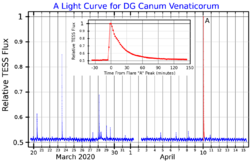Astronomy:DG Canum Venaticorum
 A light curve for DG Canum Venaticorum, plotted from TESS data.[1] The main plot shows both the low amplitude periodic oscillations, and several flares. The inset plot shows the strongest flare with an expanded time scale. | |
| Observation data Equinox J2000.0]] (ICRS) | |
|---|---|
| Constellation | Canes Venatici |
| Right ascension | 13h 31m 46.617s[2] |
| Declination | +29° 16′ 36.72″[2] |
| Apparent magnitude (V) | 12.02[3] (12.64 + 12.93) |
| Characteristics | |
| Spectral type | M4.0Ve[3] |
| Variable type | Flare star + BY Dra[4] |
| Astrometry | |
| Radial velocity (Rv) | −7.50±6.50[3] km/s |
| Proper motion (μ) | RA: −244.1±4.2[3] mas/yr Dec.: −132.4±4.8[3] mas/yr |
| Parallax (π) | 55.51 ± 2.38[3] mas |
| Distance | 59 ± 3 ly (18.0 ± 0.8 pc) |
| Absolute magnitude (MV) | 10.74[3] (11.36 + 11.65) |
| Details | |
| A | |
| Mass | 0.39[5] M☉ |
| Radius | 0.253[6] R☉ |
| Temperature | 3,263[6] K |
| Metallicity [Fe/H] | 0.15[7] dex |
| Rotational velocity (v sin i) | 50[8] km/s |
| B | |
| Mass | +0.07[6] M☉ |
| Age | 30[8] Myr |
| Other designations | |
| Database references | |
| SIMBAD | data |
| ARICNS | data |
DG Canum Venaticorum is a variable binary star system[3] in the northern constellation of Canes Venatici. As of 2009, the pair have an angular separation of 0.20″ along a position angle of 285°, which corresponds to a physical separation of around 3.6 AU.[8] With an apparent visual magnitude of 12.02, the pair are much too faint to be seen with the naked eye.[3] Parallax measurements place the system at a distance of roughly 59 light years from the Earth.[3]
The stellar classification of the primary component is M4.0Ve, indicating it is a red dwarf with emission lines present. It is considered a very young system with an estimated age of just 30[8] million years and a higher metallicity than the Sun.[7] One of the components is rotating rapidly, with a projected rotational velocity of 50 km/s.[3] At least one of the members of this system is a type of variable known as a flare star, which means it undergoes brief increases in brightness at random intervals. On April 23, 2014, a gamma-ray superflare event was observed by the Swift satellite coming from the position of this system. It may have been perhaps the most luminous such events ever observed coming from a red dwarf star. A secondary radio flare was observed a day later.[8]
References
- ↑ "MAST: Barbara A. Mikulski Archive for Space Telescopes". Space Telescope Science Institute. https://mast.stsci.edu/portal/Mashup/Clients/Mast/Portal.html.
- ↑ 2.0 2.1 Høg, E. et al. (March 2000), "The Tycho-2 catalogue of the 2.5 million brightest stars", Astronomy and Astrophysics 355: L27–L30, doi:10.1888/0333750888/2862, ISBN 0333750888, Bibcode: 2000A&A...355L..27H.
- ↑ 3.00 3.01 3.02 3.03 3.04 3.05 3.06 3.07 3.08 3.09 3.10 Riedel, Adric R. et al. (2014), "The Solar Neighborhood. XXXIII. Parallax Results from the CTIOPI 0.9 m Program: Trigonometric Parallaxes of Nearby Low-mass Active and Young Systems", The Astronomical Journal 147 (4): 85, doi:10.1088/0004-6256/147/4/85, Bibcode: 2014AJ....147...85R.
- ↑ Samus, N. N. et al. (2009). "VizieR Online Data Catalog: General Catalogue of Variable Stars (Samus+ 2007-2013)". VizieR On-line Data Catalog: B/GCVS. Originally Published in: 2009yCat....102025S 1. Bibcode: 2009yCat....102025S.
- ↑ Cortés-Contreras, M.; Béjar, V. J. S.; Caballero, J. A.; Gauza, B.; Montes, D.; Alonso-Floriano, F. J.; Jeffers, S. V.; Morales, J. C. et al. (2017). "CARMENES input catalogue of M dwarfs. II. High-resolution imaging with Fast Cam". Astronomy & Astrophysics 597: A47. doi:10.1051/0004-6361/201629056. Bibcode: 2017A&A...597A..47C.
- ↑ 6.0 6.1 6.2 Houdebine, E. R; Mullan, D. J; Paletou, F; Gebran, M (2016). "Rotation-Activity Correlations in K and M Dwarfs. I. Stellar Parameters and Compilations of v sin i and P/sin i for a Large Sample of Late-K and M Dwarfs". The Astrophysical Journal 822 (2): 97. doi:10.3847/0004-637X/822/2/97. Bibcode: 2016ApJ...822...97H.
- ↑ 7.0 7.1 Newton, Elisabeth R. et al. (January 2014), "Near-infrared Metallicities, Radial Velocities, and Spectral Types for 447 Nearby M Dwarfs", The Astronomical Journal 147 (1): 24, doi:10.1088/0004-6256/147/1/20, 20, Bibcode: 2014AJ....147...20N.
- ↑ 8.0 8.1 8.2 8.3 8.4 Fender, R. P. et al. (January 2015), "A prompt radio transient associated with a gamma-ray superflare from the young M dwarf binary DG CVn", Monthly Notices of the Royal Astronomical Society: Letters 446 (1): L66–L70, doi:10.1093/mnrasl/slu165, Bibcode: 2015MNRAS.446L..66F.
- ↑ "DG CVn -- Flare Star", SIMBAD Astronomical Database (Centre de Données astronomiques de Strasbourg), http://simbad.u-strasbg.fr/simbad/sim-id?Ident=DG+Canum+Venaticorum, retrieved 2016-03-11.
External links
- Reddy, Francis (September 29, 2014), NASA's Swift Mission Observes Mega Flares from a Mini Star, NASA, https://www.nasa.gov/content/goddard/nasas-swift-mission-observes-mega-flares-from-a-mini-star, retrieved 2016-03-12.
 |

